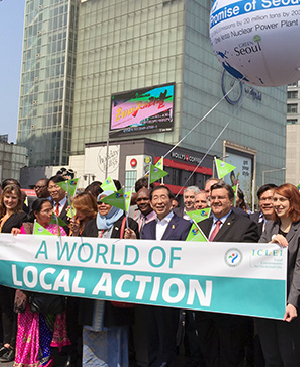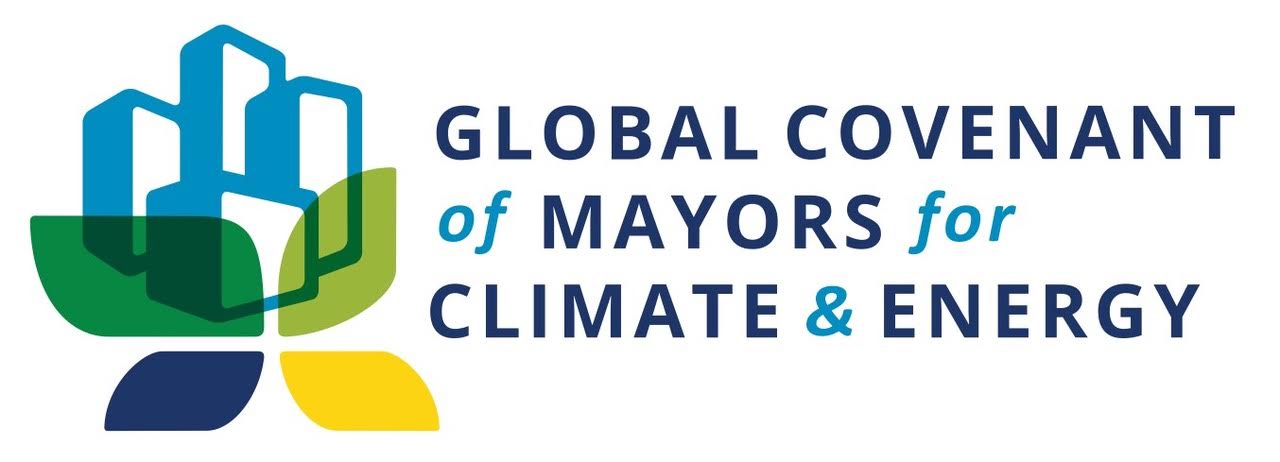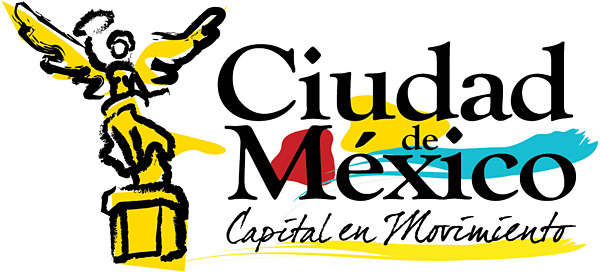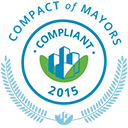- Home
- Reporting entities
- México City Government
México City Government
Mexico Mayor: Claudia Sheinbaum Pardo-
Population 8851080

-
Area 1485.0km 2
-
GDP 2.1 BillionMXN
-
Targets by N/A N/Aemission
Targets by México City Government
There are no targets yet
- Start year:
- Type: Technical/Infrastructure investment
- Status: In operation
- Waste
- Start year:
- Type: Education/Awareness Raising
- Status: In operation
- Facilities
- Start year:
- Type: Education/Awareness Raising
- Status: In operation
- Transport
- Start year:
- Type: Technical/Infrastructure investment
- Status: In operation
- Start year: 2008
- Type: Technical/Infrastructure investment
- Status: Completed
Process the organic fraction recovered in separation programs for humus
production, for reincorporation to green areas and eroded zones
in Mexico City as organic fertilizer, as well as in the vegetation cover of
Bordo Poniente
- Waste
- Start year: 2008
- Type: Technical/Infrastructure investment
- Status: Completed
Promotion of the use of renewable energy in the Metrobus system, by installing photovoltaic panels in stations to generate electric power, and replacement of fluorescent lighting by technology based on light-emitting diodes (LEDs), in order to obtain benefits in operating and maintenance costs of the station and in the reduction of greenhouse gas emissions
Read More Read Less- Facilities
- Start year: 2008
- Type: Policy/Strategies/Action Plans
- Status: Completed
Provide the public passenger transportation service exclusively with high-reliability trolley buses, on confined lanes in Eje Central, thus contributing to the policy of the city government to build an ecological corridor
that generates tangible benefits for people moving on this road
- Transport
- Start year: 2008
- Type: Technical/Infrastructure investment
- Status: Completed
The intention is to contribute to combat climate change by reducing GHG and contaminant emissions generated by public passenger transportation, by replacing obsolete medium and low-capacity units by high-capacity buses and with state-of the art technology, to obtain improvements in air quality, health conditions and quality of life. This
addressing the public passenger transportation needs along the main
transportation corridors of the city, providing a system that decreases
travel times and improves the quality of current services. Also, it also seeks to give priority to public passenger transportation, replacing current schemes by a high-capacity intensive service and equipped with infrastructure for efficient operation and accessible to any user.
- Residential

- Start year: 2008
- Type: Policy/Strategies/Action Plans
- Status: Completed
Modify the scheme in the provision of the franchised collective public service, through a new concept, Franchised Corridors.
Read More Read Less- Transport
- Start year:
- Type: Education/Awareness Raising
- Status: Completed
Improve, in terms of coverage and quality, the attention to social demonstrations
on public roads in Mexico City, in order to reduce impacts on mobility and the environment. Since the creation of the Urban Coexistence Specialized Unit (UECU) in
2007, which aims to reduce the time of attention to social demonstrations
that occur on public roads, through the creation of five corridors (Reforma Corridor, South area Corridor, North area Corridor, East Corridor, West Corridor), the time of attention has been reduced in 50% (from 40 min. to 20 min. in average for the time of arrival of personal with
attention proposal), the time it takes for personnel of the DGCPyASyC
to move to the conflict place
- Facilities
- Transport
- Start year: 2010
- Type: Technical/Infrastructure investment
- Status: Completed
Reduce emissions of pollutants through the efficient use of vehicle units, and by gradual replacement of those which, due to their age and mechanical condition, are no longer affordable to use
Read More Read Less- Transport
- Start year: 2010
- Type: Technical/Infrastructure investment
- Status: Completed
Implement environment friendly technologies in all the actions taken in the park, according to the vision and mission of San Juan de Aragon Park to contribute to reducing GHG generation.Reduce by 80% the waste transported out of the park in the medium term, and use them for the generation of compost to improve soil and vegetation. Reduce the number of trips of internal combustion vehicles to the waste transfer plant and use plant, thus decreasing GHG gases by this concept.
Read More Read Less- Waste
- Start year: 2008
- Type: Technical/Infrastructure investment
- Status: Completed
Evaluation of the performance of photovoltaic systems in Mexico City
Read More Read Less- Residential
- Start year: 2008
- Type: Policy/Strategies/Action Plans
- Status: Completed
Incorporate the use of technologies friendly to the environment in new houses built by the Housing Institute of Federal District, to reduce greenhouse gas emissions
gases (GHG), within a framework of integrated planning,
and enabling improvement of the quality of life of the current population and future generations.
Form an environmental culture among users of housing and raise awareness about the importance of exploiting
solar energy, saving water and energy.
- Residential
- Start year: 2008
- Type: Technical/Infrastructure investment
- Status: Completed
Promote the use of alternative energy sources and encourage a change in the energy use policy in the nation’s capital.
Read More Read Less- Buildings
- Start year: 2008
- Type: Technical/Infrastructure investment
- Status: Completed
Save electric power during operation of trains by reducing the guide bar supply voltage, taking advantage of the electric power generated by trains during braking; modification of typical running parameters during the drive phase of trains on the routes from one station to another; optimization of service polygons maintaining the balance between supply and demand, in addition to safety and efficiency levels in the service. Also, upgrade the traction-braking system of the batch of 25 MP-82 model trains in Line 8. This is accomplished by replacing the existing system by a new system with microprocessor- based control equipment and power electronics based on insulated gate bipolar transistors (IGBTs).
Read More Read Less- Transport
- Start year: 2008
- Type: Technical/Infrastructure investment
- Status: Completed
Electric power savings by installing variable frequency drives that allow stairs operation at 20% to 30% of rated speed when there is no flow of users; savings of up to 65% in electric power consumption; increase the service life of mechanical components by having less friction between them; and modernize the control panel, allowing to carry out monitoring and remote control of electromechanical stairs.
Read More Read Less- Facilities
- Start year:
- Type: Technical/Infrastructure investment
- Status: In operation
- Transport
- Start year: 2008
- Type: Policy/Strategies/Action Plans
- Status: Completed
On 2012, there is a progress of 85% in meeting the goals, where maintenance
has been performed in little over 9,000 electromechanical
components (motor-pump-transformer). Electromechanical efficiency has been increased in 34 pumping plants
by replacement of low efficiency electromechanical equipments (20 to
50 years old). Operation of generator sets has been ensured in order to
cover electric power outages of the supply company, thus preventing
possible flooding; failures were corrected in regulation gate systems.
Also, this allowed to stop payment for penalizations and fines imposed
by the electric power supply company, by correcting the power factor
to 0.95.
- Facilities
- Start year: 2008
- Type: Technical/Infrastructure investment
- Status: Completed
www.sedema.df.gob.mx
Read More Read Less- Waste
- Other Emissions
- Start year: 2008
- Type: Technical/Infrastructure investment
- Status: Completed
Measure and assess energy and water saving with equipment and systems that take advantage of solar energy (self-sustaining). As well as the time and cost for conversion of traditional water heating systems to self-sustaining systems in existing buildings of social interest housing.
Read More Read Less- Residential
- Start year: 2008
- Type: Organizational / Governance
- Status: Completed
Incorporate in all the procurement procedures of the Mexico City Public
Administration, the characteristics and specifications established
in the General Guidelines for the Procurement of Goods with Less Environmental
Impact
- Buildings
- Waste
- Start year:
- Type: Regulatory
- Status:
With the changes made in the second semester of year 2008, private vehicles of model years that were incorporated into the program went from 10 to 8 years old; also, it was extended to Saturdays, therefore, starting this year the trend increase of CO2 emissions reduction was higher, up to year 2011; by implementation of the No Driving Day Program (PHNC), emission to the atmosphere of almost 545,000 tons of carbon dioxide was stopped, for an increase of 52% in the program efficiency from year 2007 to 2011; 41% of this reduction corresponds to the new changes
made to the program in the current administration.
- Transport
- Start year: 2008
- Type: Technical/Infrastructure investment
- Status: Completed
Incorporate the use of efficient technologies in public lighting in the primary road network of Mexico City, reducing electric power consumption and maintaining optimal levels of lighting for crime prevention.
Read More Read Less- Facilities
- Start year: 2010
- Type: Policy/Strategies/Action Plans
- Status: Completed
Increase bike intermodality. This intermodality will be promoted mainly with the public transportation network through an efficient
transportation alternative. This system allows having a bike available in different bicycle stations
in the origin-destination, supporting more efficient trips by users by generating a faster and economic mobility option. This
contributes to increased bicycle trips in the city. Providing the city with an individual efficient
and non-polluting transportation alternative helps to reduce
the distance of trips made in polluting transportations options, in the medium and long term.
- Transport
- Start year: 2009
- Type: Technical/Infrastructure investment
- Status: Completed
Service innovation in Circuito Bicentenario with high-technology units,
represents providing the public transportation service with a modern,
more efficient vehicle fleet, and significantly less polluting, as well as meeting the safety and comfort requirements, making this transportation means attractive for the city.
- Transport
- Industrial processes and product use (IPPU)
- Start year: 2008
- Type: Technical/Infrastructure investment
- Status: Completed
Promote the use of solar energy in commercial and service sectors
Read More Read Less- Residential
- Commercial
- Industrial
- Start year: 2008
- Type: Technical/Infrastructure investment
- Status: Completed
Implement actions that allow generation of electric power savings in the facilities of the Electric Transportation Service
Between 2009 and 2012 energy saving lamps (fluorescent T5, T8 and compact), electronic ballasts, LED and low discharge lamps have been installed. Operation of photocells has been checked in outdoor lighting. Sectioning of electric circuits has been carried out and preventive maintenance has been performed in electrical installations.
Behavior of electric power consumption and billing is tracked for the Electric Transportation Service
- Facilities
- Start year: 2008
- Type: Assessment/Research
- Status: Completed
"Improve continuity of service and leverage existing infrastructure, by
increasing electromechanical, physical and operating efficiency levels
of the drinking water network of Sierra de Santa Catarina in Delegation
Iztapalapa. The project was conducted on 2008, and in the face of the need to
reduce the problem of water supply on the area, it was resumed and
feedback was obtained in 2011."
- Industrial processes and product use (IPPU)
- Start year: 2008
- Type: Technical/Infrastructure investment
- Status: Completed
The Mexico City Government will promote modernization of the
vehicle fleet for public and franchised passenger transportation, and will establish mechanisms to organize and regulate the taxi
service. Through this program, microbuses that offer the franchised public passenger transportation service in Mexico City are replaced by new buses with new technologies to reduce pollutant emissions.
- Transport
- Start year: 2011
- Type: Technical/Infrastructure investment
- Status: Completed
Expand the transportation service to solve the mobility problems in a specially designed route, which links the city downtown with a development center as Santa Fe, and simultaneously piloting the use of compressed
natural gas as an alternative fuel in 30 buses with benefits that
invite to leave the car, and avoid the different transfers that users had
to make before this service, which was supplemented by an irregular service of private cars that provided transportation to Santa Fe in poor safety conditions.
- Transport
- Start year: 2011
- Type: Technical/Infrastructure investment
- Status: Completed
Painting and waterproofing of decks in the premises that make up the fruit, vegetables, groceries and food markets with a reflective material (white aliphatic urethane polymer), reducing temperature inside warehouses in up to 4°C and electric power consumption due to the high reflectance.
Read More Read Less- Buildings
- Facilities
- Start year: 2008
- Type: Technical/Infrastructure investment
- Status: Completed
Have the necessary lighting to offer visitors greater security and tranquility in the Second Section of Chapultepec Park, making this space self-sustainable in the area of lighting and reducing the cost of electric power use and reduce GHG emissions.
Read More Read Less- Facilities
- Start year: 2008
- Type: Technical/Infrastructure investment
- Status: Completed
Make the Public Lighting Laboratory building of the Mexico City Government self-sustainable through installation of alternative energy for electric power . Reduce electric power consumption and CO2 emissions to the environment generation and Familiarize and sensitize society about use of renewable energy creating environmental awareness in the population.
Read More Read Less- Transport
- Start year:
- Type: Technical/Infrastructure investment
- Status: In operation
- Facilities
- Transport
- Start year: 2008
- Type: Technical/Infrastructure investment
- Status: Completed
Facilitate renewal of the vehicle fleet that provides the Public Individual
Passenger Transportation Service “Taxi”, with new units that meet the
characteristics required by the Ministry of Transportation and Roads, in order to provide a safe and quality service to users, and to contribute to improve environmental conditions in Mexico City.
- Transport
- Start year:
- Type: Organizational / Governance
- Status: In operation
- Transport
- Start year: 2008
- Type: Policy/Strategies/Action Plans
- Status: Completed
This action was initiated on 2008 under the name of “Non-Motorized Mobility Corridors Program”. On 2009, due to the conceptualization of the model for Mexico City, which was achieved in conjunction with NAUM and the Danish firm Gehl Architects, the program was renamed to “Bike Mobility Strategy for Mexico City” (EMB). Make bicycle an alternative for a comfortable, viable and safe transportation to achieve an equitable, competitive, sustainable and healthy city
Read More Read Less- Facilities
- Transport
- Start year: 2008
- Type: Technical/Infrastructure investment
- Status: Completed
Replace the Passenger Transportation Network (PTN) of Mexico City
with more than 10.25 years of circulation, by a modern vehicle fleet,
significantly more efficient and less polluting, with the aim of offering
a quality, economic and timely public transportation service, 365 days a
year, with safety and comfort requirements, maintaining a model public
body of the Mexico City Government and the best transportation operation
as a social benefit to low-income people and peripheral areas, to
help integrate and regulate transportation system in Mexico City
- Transport
- Start year: 2008
- Type: Technical/Infrastructure investment
- Status: Completed
Improve security conditions in San Juan de Aragon Park by installation of solar (photovoltaic) luminaires with LED lamps. Implement environment friendly technologies in all the actions performed in San Juan de Aragon Park
Read More Read Less- Facilities
- Start year:
- Type: Education/Awareness Raising
- Status: In operation
- Transport
- Start year: 2008
- Type: Technical/Infrastructure investment
- Status: In operation
Reduce the environmental impacts associated with the use of conventional lamps in traffic lights for traffic signaling and pedestrian crossing with efficient LED technology systems.
Read More Read Less- Facilities
- Start year: 2008
- Type: Technical/Infrastructure investment
- Status: Completed
Upgrade the lighting system in Public Transportation System stations by replacing the fluorescent lighting system (T12) of obsolete technology by an energy of lighting circuits.saving lighting system (T8), and installation of a control system
Read More Read Less- Facilities

- Start year: 2010
- Type: Technical/Infrastructure investment
- Status: Completed
Over the years, the main concern of the city government has been encouraging a separate
collection process with public participation to consolidate the environmental impact, together
with the use of waste that avoids or decreases gradually the final disposal in landfill cells, usingtechnologies for organic waste recovery and recyclable or reusable products. The Ministry of Works and Services through the General Department of Urban Services, has
been the Administrative Unit responsible for the operation and maintenance of the Bordo
Poniente Landfill Stage IV; however, this space served its useful life in December 19, 2011,
therefore, from this date, urban solid waste generated in Mexico City is sent for final disposal
to authorized sites in the State of Mexico.
- Waste
- Start year: 2011
- Type: Technical/Infrastructure investment
- Status: Completed
Selection of waste with high calorific power, separation in the Sorting
Plant of San Juan de Aragon, and their transport by CEMEX to their cement
plants for use as an alternative fuel
- Transport
- Waste
- Start year: 2008
- Type: Policy/Strategies/Action Plans
- Status: Completed
Complete conversion of fuel use from diesel to natural gas08/10/2013; Application of the “hot mix asphalt” technology, whose use
reports savings of 16% in fuel consumption; Perform environmental studies and audits; Change heavy machinery for exploitation work, material hauling and transportation.
- Industrial processes and product use (IPPU)
- Start year: 2008
- Type: Regulatory
- Status: In operation
The purpose of the program is to maintain the vehicle fleet of Mexico City and the metropolitan zone in optimum conditions, through semiannual inspection of contaminant emissions, to achieve an adequate energy and environmental performance. Vehicle verification has been strengthened applying more stringent
emission limits for gasoline units in circulation since year 2007, and from July 2008, with a new procedure and new emission limits for diesel-powered units. In addition to the semi-annual update of the Vehicle Verification Program, work has been carried out on the development of new vehicle verification equipment, where the software and hardware will allow to maintain better control, both in the vehicle verification process as well as with the actors involved in it, such as equipment vendors, owners of verification centers, and verification technicians. Replacement of equipment began in the second half of 2011, and operation of all verification centers with the new equipment is expected on July 2012 (GDF-09).
- Transport
- Start year: 2008
- Type: Policy/Strategies/Action Plans
- Status: Completed
The Bike Program (“Muévete en Bici”) operates every Sunday of the year through Sunday bike rides on Paseo de la Reforma with a circuit of 23 km, from 8:00 to 14:00 hrs, open to citizens who like bike riding, walking, jogging , skating or touring. This program is run by the Ministry of the Environment. Family Ciclotons run by the Sports Institute
of the Mexico City Government are organized every last Sunday of the
month.
- Transport
- Industrial processes and product use (IPPU)
- Start year: 2008
- Type: Education/Awareness Raising
- Status: In operation
Execute actions of rational and efficient use of water that allow to reduce. In the framework of the Environmental Management System of the
Mexico City Government, awareness actions are taken geared at engaging
agencies in actions of rational and efficient use of water. To
integrate this action in its policies, the Mexico City Government established
the General Guidelines for the Procurement of Goods with Characteristics and Specifications of Less Environmental Impact, that establish the type of water saving products that must be purchased by the different agencies the environmental impact associated with their use in public offices
and buildings of the Mexico City Government.
- Buildings
- Start year: 2008
- Type: Technical/Infrastructure investment
- Status: Completed
Implement actions that applied to operation of electrical equipment in wells and pumping plants of the Mexico City Water System, generate savings in electric power consumption.
Read More Read Less- Facilities
- Start year: 2009
- Type: Technical/Infrastructure investment
- Status: Completed
www.sedema.df.gob.mx
Read More Read Less- Industrial processes and product use (IPPU)
- Agriculture, Forest and Other Land Use (AFOLU)
- Start year: 2010
- Type: Policy/Strategies/Action Plans
- Status: Completed
Transit was improved for the public passenger transportation with the
implementation of a non-contaminant mass transportation service,
by removing from the corridor franchised transportation and Passenger
Transportation Network units, in addition to restricting cargo
transportation traffic.
- Transport
- Start year: 2008
- Type: Technical/Infrastructure investment
- Status: Completed
Reduce environmental impacts associated to use of conventional lighting at buildings of the Mexico City Public Administration, replacing by electric power saving lighting equipment
Read More Read Less- Buildings
- Facilities
- Start year: 2008
- Type: Technical/Infrastructure investment
- Status: Completed
Decrease consumption of electric power for public lighting, improving lighting in secondary roads in Delegation Iztapalapa, and increasing security of the population 7,700 luminaires were installed in secondary roads in Delegation Iztapalapa, replacing the lamp-ballast assembly of the conventional system (250 W electromagnetic ballast) by 200 W dimmable electronic ballasts and Pulse Start metal halide lamps.
Read More Read Less- Facilities
- Start year: 2008
- Type: Education/Awareness Raising
- Status: Completed
Creation and recovery of public spaces to make the city a place of social integration that provides better livability, comfort and equity
Read More Read Less- Residential
- Start year: 2009
- Type: Regulatory
- Status: Completed
Reduce the number of trips made by private cars in order to free up
space on roads and to avoid the pollutant emissions caused by private
cars. The Program implementation began in the school year 2009-2010,
with the participation of six schools. Currently, 27 schools with an enrollment
of about 27,000 students are participating in the school transportation
Program in Phase III; of these, 22.9% on average arrive and
leave the school on foot, by public transportation or a clean means,
29.1% of students arrive by car and 48.0% use school transportation in
574 school buses
- Transport
- Start year: 2008
- Type: Technical/Infrastructure investment
- Status: Completed
Increase the use of renewable energy using photovoltaic cells to generate the electric power required to illuminate the exterior signaling in metro stations and replace existing lamps (fluorescent T12) by technology based on light emitting diodes (LEDs).
Read More Read Less- Facilities
- Start year: 2010
- Type: Technical/Infrastructure investment
- Status: Completed
Perform urban solid waste separation in sorting plants of the Mexico City Government, thereby reducing the GHG emissions generated, by
avoiding the use of virgin material in the manufacture of various items
- Waste
- Start year:
- Type: Technical/Infrastructure investment
- Status: In operation
- Facilities
The México City Government has reported 2 Community emission inventories, since 2010. In its latest inventory, compiled in 2012, the Transport, Stationary energy, Waste management, Agriculture, forest and other land use, Agriculture, forest and other land use and Industrial process and product use are identified as key emission sources.
The México City Government has reported 2 government operational inventories, since 2010. In its latest inventory, compiled in 2012, the Waste management and Transport are identified as key emission sources.
Mayor Claudia Sheinbaum PardoMéxico City Government, Mexico





